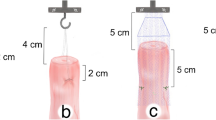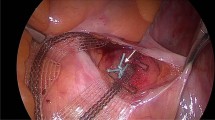Abstract
Introduction and hypothesis
Pullout force of mesh from tissue is one of the important mechanical properties of an implanted mesh to repair pelvic organ prolapse (POP). The EndoFast Reliant™ system kit allows mesh attachment with soft-tissue fasteners. The aim of this study was to compare the pullout force that developed in mesh that was attached by EndoFast Reliant fasteners to mesh that was attached by trocar-based methods (tunnel, pocket) in a sheep model.
Methods
Six sheep underwent mesh attachment with three methods (EndoFast Reliant, tissue pocket, tissue tunnel), and each method was repeated five times in both thighs of the same sheep. The pullout force was measured at different time intervals from surgery: 0, 3, 7, 15, 30, and 45 days. Statistical analysis was performed by using the appropriate one-way analysis of variance (ANOVA) for each time interval and a general linear model for repeated measures using IBM® SPSS® software version 20.0.0.
Results
During the immediate postoperative period (0–3 days), pullout force was significantly higher with EndoFast Reliant than with tissue pocket or tissue tunnel. At day 7, this trend continues without statistical significance. Pullout force increased progressively until day 15, when the force caused the mesh to tear; it was similar in all three groups. ANOVA showed significant effect of time and study group.
Conclusions
The EndoFast Reliant system provides significantly stronger attachment in the immediate postoperative period (0–3 days) compared with trocar-based techniques, and this difference disappeared at day 15 postsurgery.



Similar content being viewed by others
References
Weber AM, Walters MD, Piedmonte MR et al (2001) Anterior colporrhaphy: a randomized trial of three surgical techniques. J Obstet Gynaecol 185:1299–1306
Sand PK, Koduri S, Lobel RW, Winkler HA, Tomezsko J, Culligan PJ, Goldberg R (2001) Prospective randomized trial of polyglactin 910 mesh to prevent recurrence of cystoceles and rectoceles. Am J Obstet Gynecol 184(7):1357–1362
Nieminen K, Hiltunen R, Takala T et al (2010) Outcomes after anterior vaginal wall repair with mesh: a randomized, controlled trial with 3 year follow-up. Am J Obstet Gynecol 203:235e1–235e8
Altman D, Väyrynen T, Engh ME, Axelsen S, Falconer C; Nordic Transvaginal Mesh Group. (2011) Anterior colporrhaphy versus transvaginal mesh for pelvic-organ prolapse. N Engl J Med. 12;364(19):1826–36.
Vollebregt A, Fischer K, Gietelink D, van der Vaart CH (2011) Primary surgical repair of anterior vaginal prolapse: a randomised trial comparing anatomical and functional outcome between anterior colporrhaphy and trocar-guided transobturator anterior mesh. BJOG 118(12):1518–1527
Keys T, Campeau L, Badlani G (2012) Synthetic mesh in the surgical repair of pelvic organ prolapse: current status and future directions. Review. Urology 80(2):237–243
Urogynecologic surgical mesh: Update on the safety and effectiveness of transvaginal placement for pelvic organ prolapse. FDA – CDRH Report. July 2011.
Mourtialon P, Letouzev V, Eglin G, de Tayrac R & the French Ugytex Study Group (2012) Cystocele repair by vaginal route: comparison of three different surgical techniques of mesh placement. Int Urogynecol J 23:699–706
Alcalay M, Cosson M, Livneh M, Lucot JP, von Theobald P (2011) Trocarless system for mesh attachment in pelvic organ prolapse repair–1-year evaluation. Int Urogynecol J Pelvic Floor Dysfunct 22:551–556
Abramowitch SD, Feola A, Jallah Z, Moalli PA (2009) Tissue mechanics, animal models, and pelvic organ prolapse: a review. Eur J Obstet Gynecol Reprod Biol 144(Suppl 1):S146–S158
Yildirim A, Basok EK, Gulpinar T, Gurbuz C, Zemheri E, Tokuc R (2005) Tissue reactions of 5 sling materials and tissue material detachment strength of 4 synthetic mesh materials in a rabbit model. J Urol 174(5):2037–2040
Zorn KC, Spiess PE, Singh G, Orvieto MA, Moore B, Corcos J (2007) Long-term tensile properties of tension-free vaginal tape, suprapubic arc sling system and urethral sling in an in vivo rat model. J Urol 177(3):1195–1198
Krause H, Goh J (2009) Sheep and rabbit genital tracts and abdominal wall as an implantation model for the study of surgical mesh. J Obstet Gynaecol Res 35(2):219–224
Paula E, Silva E, Rosa EL, Barbosa SV (2001) Tissue reactions of polypropylene mesh used in maxillofacial trauma. Braz Dent J 12(2):121–125
Boukerrou M, Rubod C, Dedet B, Boodhum R, Nayama M, Cosson M (2008) Tissue resistance of the tension-free procedure: what about healing? Int Urogynecol J Pelvic Floor Dysfunct 19(3):397–400
Marcus Braun N, von Theobald P (2013) Cystocele repair with single incision, trocarless mesh system. Int Urogynecol J. (in press)
Conflicts of interest
Dr. Alcalay was a consultant of IBI at the time of the study.
Dr. Livneh and Mr Hod were employed by IBI at the time of the study.
Author information
Authors and Affiliations
Corresponding author
Rights and permissions
About this article
Cite this article
Alcalay, M., Livneh, M., Braun, N.M. et al. Mesh pullout force: comparative study of different deployment techniques in a sheep model. Int Urogynecol J 25, 103–107 (2014). https://doi.org/10.1007/s00192-013-2162-3
Received:
Accepted:
Published:
Issue Date:
DOI: https://doi.org/10.1007/s00192-013-2162-3




